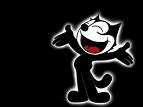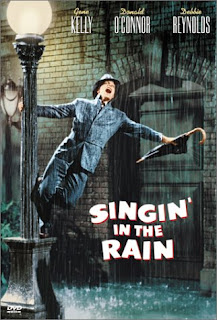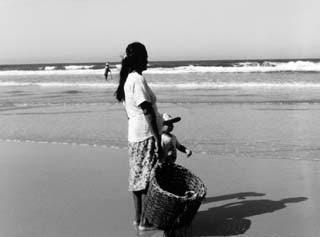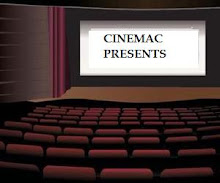Singing in the rain
(02/18/2004)
The movies served as form of record for the dance performance and had a fundamental purpose in its preservation over the twentieth century. The film musical combined American forms of ballet (ballroom dancing, tap dancing and acrobatic dance) with the romantic and comic opera.
(02/18/2004)
The movies served as form of record for the dance performance and had a fundamental purpose in its preservation over the twentieth century. The film musical combined American forms of ballet (ballroom dancing, tap dancing and acrobatic dance) with the romantic and comic opera.
Historically, the film musical was born with the sound cinema, "The Jazz Singer", in 1927, opened at the same time the talkies and the singing cinema. However, the movie musical has become established in the United States along the lines of Broadway shows, and had its real heyday with Vincent Minnelli, who brought to the big screen his experience in musical theater.
Besides Minnelli, there are other great creators of the film musicals, such as the directors Busby Berkeley, Stanley Donen, actors like Fred Astaire, Dick Powell and Bing Crosby, actress like Ginger Rogers, Betty Grable, Cyd Charisse, Judy Garland, choreographers like Bob Fosse, Robert Alton, Charles Walters and Michael Kidd, actor / director Gene Kelly.
Besides Minnelli, there are other great creators of the film musicals, such as the directors Busby Berkeley, Stanley Donen, actors like Fred Astaire, Dick Powell and Bing Crosby, actress like Ginger Rogers, Betty Grable, Cyd Charisse, Judy Garland, choreographers like Bob Fosse, Robert Alton, Charles Walters and Michael Kidd, actor / director Gene Kelly.
The film musical is basically characterized by presenting scripts that mix dance, music, and singing and has the choreography as its strength. In "Singing in the Rain" Gene Kelly brought the art of the dance to the film, managed to bring back an aesthetic that had virtually lost since the days of silent films, he put together, in a magnificent way, the elements of dance and music in the body of the narrative, combining with perfection the tap dance and the ballet. The most famous dance number in film history is Gene Kelly's solo dance in "Singing in the Rain". The sequence in which Kelly sings and dances in the rain, became an innovative tap dance number. The sound effects are caused both by the rain falling into the puddles when Kelly jumps on them and kicks, as much as by the noise of his tap dancing. The artist dramatized dance in the rain with his athletic and exaggerated movements, and his lively and youthful exuberance. What is observed is the naturalness with which Gene Kelly surrenders when he's dancing, he expresses a contagious zest for life, also shows that he is in love. Love is present, both the love for the character of Debbie Reynolds, as well as the dance. The moment when he plays with the umbrella, and with other elements of the scenery is excellent. When Kelly goes up to the pole of the street, his presence is exalted, his movements are masterful. Gene Kelly was also the choreographer and with Stanley Donen, delivered the scene that became to most memorable of all time. The Music "Singin 'in the Rain" was composed by Nacio Herb Brown and arranged for the film by Roger Edens. The lyrics by Arthur Freed was adapted by Kelly, who added "and dancin '" to the back of the title. Cinematography by Harold Rosson. "Singing in the Rain" was released in the United States in April 1952, and had a huge success of public and box office. Over the time, the film also received recognition from the critics. "Singing in the Rain" is in 10th place of the list of the 100 Greatest Movies, selected by American Film Institute.
The story of the film is basically to "create a memorable show", but not a mere spectacle, but the first musical movie. Gene Kelly is Don Lockwood, a famous Hollywood star of the silent movies era, his films are a success, but his life begins to change with the arrival of the sound cinema. His challenge is to mount a musical in spite of the difficulties he finds with the new technique of film making. "Singing in the Rain" is a masterpiece, an unforgettable American classic that captivates and moves. Gene Kelly is brilliant, Donald O'Connor is amazing, hilarious, can charm the viewer with his jokes. Debbie Reynolds also has her presence, with her own style she switches a fine line between comedy and drama. Cyd Charisse is beautiful, and dance beautifully. Gene Kelly, whose perfectionism led his partners to dance to exhaustion, masterminded the choreography of the sequence "Broadway Ballet". It is said that the veil of silk used by Cyd Charisse, with more than seven feet long, was kept flowing by three engines. "Singing in the Rain" won the Golden Globe for Best Comic Actor (Donald O'Connor).
Synopsis:
The story of the film is basically to "create a memorable show", but not a mere spectacle, but the first musical movie. Gene Kelly is Don Lockwood, a famous Hollywood star of the silent movies era, his films are a success, but his life begins to change with the arrival of the sound cinema. His challenge is to mount a musical in spite of the difficulties he finds with the new technique of film making. "Singing in the Rain" is a masterpiece, an unforgettable American classic that captivates and moves. Gene Kelly is brilliant, Donald O'Connor is amazing, hilarious, can charm the viewer with his jokes. Debbie Reynolds also has her presence, with her own style she switches a fine line between comedy and drama. Cyd Charisse is beautiful, and dance beautifully. Gene Kelly, whose perfectionism led his partners to dance to exhaustion, masterminded the choreography of the sequence "Broadway Ballet". It is said that the veil of silk used by Cyd Charisse, with more than seven feet long, was kept flowing by three engines. "Singing in the Rain" won the Golden Globe for Best Comic Actor (Donald O'Connor).
Synopsis:
During the transition from silent films to sound film, Don Lockwood (Kelly) falls in love with singer Kathy Selden (Debbie Reynolds) chosen to dub the shrill voice of the star Lina Lamont (Jean Hagen).
Credits:
Credits:
Singin 'in the rain EUA/1952
Directors: Gene Kelly and Stanlen Donen
With: Gene Kelly, Donald O'Connor, Debbie Reynolds, Jean Hagen, Milllard Mitchell, Cyd Charisse.
MGM Musical/103 MGM minutes.
Directors: Gene Kelly and Stanlen Donen
With: Gene Kelly, Donald O'Connor, Debbie Reynolds, Jean Hagen, Milllard Mitchell, Cyd Charisse.
MGM Musical/103 MGM minutes.














